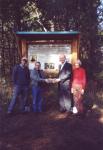 | |||||||||
MILLENNIUM WALKWAY CONSTRUCTION HISTORYThe Millennium Walkway was the official Millennium Project undertaken by the City of Castlegar in 1999 for scheduled completion in 2000. I was invited to be part of the steering committee for the project and my contributions included the responsibility for developing the history-related enhancements such as the interpretive sign panels and the concept for the cast pavement medallion. Because of budgetary constraints, the project had to be scaled back somewhat, but it opened on schedule. The Walkway became an unqualified success. In 2003 the City extended the Walkway further upstream along the shoreline of the Columbia River to the border of the park property. This gave me an opportunity to produce one additional sign on Albert McCleary, which was funded from a payment the Friends of Parks and Trails Society had received for my previous work. The City cooperated in developing this location as a viewpoint with a paved sidewalk and a memorial bench dedicated to Vi Wilcox.
In addition to the sign development, I was able to contribute in one other way. In the spring of 2002, the City decided to act on my suggestion and relocate the David Thompson Monument from its previous location overlooking the Kinnaird Bridge to a spot on the Walkway. It was originally accepted that to move the entire monument would be too costly an undertaking and the plan was to relocate the plaque only. As I felt the stone monument had far more value as an integral unit, I decided to find a way to move it at an affordable cost. I contacted Roger Eddy, the Parks Canada official that the City had been working with. He sent me photographs of the previous move from its original location by the Castlegar-Robson Ferry ramp in November of 1977, and then he proceeded with efforts to get the required approval for the move from the National Monuments Board. With the photographs in hand, I contacted Greg Dixon, Project Manager for Peter Kiewit Sons Co. and he promised me a 40 ton crane if I could find the transport for it and the monument itself. I wrote letters requesting support and in the end obtained commitments from Dell Transport to move the giant crane and from Andrew Evin to offer me a low-bed for moving the monument itself, which weighed nearly 20 tons. Castlegar Public Works did the excavation work at both sites and installed a protective cover on the monument to keep the chains from damaging it during the transfer process. My major worry was the height of the monument which, at over 16 feet high when on the low-bed, made it tricky to move under low overhead bridge spans and utility cables. I quickly determined that the only way to get it to the down-town location was via Brilliant; where the sloping Brilliant Bridge ramp provided sufficient clearance on the opposite side of the road. Prior to the move, I had measured all the cable clearances with an insulated pole which I then took along when I accompanied the low-bed driver in case cables had to be lifted over the monument. I also developed a schedule for June 5 to coordinate the complex moves and to accommodate the publicity requirements.
The crane was delivered to the site from the Kiewit operation at the Seven Mile Dam on the Pend d?Oreille River. After the monument was loaded on the low-bed truck, we set off with the Castlegar Public Works vehicle acting as pilot car. At the Brilliant Bridge Underpass the pilot car stopped all opposing traffic so that we could clear the bridge deck in the opposing lane. In the down-town area I had to lift two telephone lines over the top of the monument, but otherwise the tricky transport went smoothly. A problem developed when a computer glitch prevented the Kiewit crane from retracting its outriggers and its arrival was delayed. In due time it showed up and was driven into position across the paved Walkway which had been previously protected with a bed of sand and heavy planking by the Kiewit team. The monument was transferred to its new location very quickly and efficiently, and the Public Works crew filled the hole. Later a curved sidewalk was added, leading from the Walkway to the base of the monument. The new setting for the monument is ideal as it is very close to the location where Thompson would have camped on the night of Sept. 5 1811. In this setting it also complements the Star-gazer sign panel which I had developed for the Walkway earlier, and which is located a short distance across the pedestrian bridge. We were all pleased with the final result.
Chronology & Acknowledgments: (my involvement) 1999 Research and sign development work. 2000 Sign production 2002 Relocation of David Thompson monument.
2004 Enhancement of McCleary viewpoint and installation of Vi Wilcox bench. The bench was paid for by donations. 2005 I replaced the vandalized Tin Cup Rapids sign with a high quality silk-screened product which is more attractive, durable, and vandal-proof than the original vinyl signs. My work included a complete redesign to incorporate the Columbia River motif and the other graphic elements of my Waldie sequence. 2007 Grants from Columbia Power Corporation and the City of Castlegar allowed me to replace the remaining history panels on the Walkway with redesigned silk-screened signs and to modify the frames for greater protection from wilful damage. | |||||||||
|
All rights reserved. Information is provided for personal use only. Use in any other application without permission is forbidden. |








